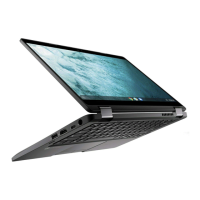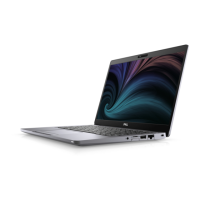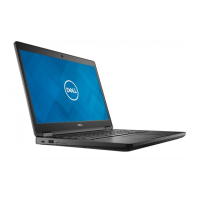Table 13. Diagnostic LEDs
Blinking
Pattern
Problem Description Suggested Resolution
Amber White
2 1 CPU failure Replace the system board
2 2 System board failure (included BIOS corruption or ROM error) Flash latest BIOS version. If problem persists,
replace the system board.
2 3 No memory/ RAM detected Confirm that the memory module is installed
properly. If problem persists, replace the
memory module.
2 4 Memory/ RAM failure Replace the memory module.
2 5 Invalid memory installed Replace the memory module.
2 6 System board/ Chipset error Replace the system board.
2 7 LCD failure Replace the LCD module.
2 8 LCD Power rail failure Replace the system board
3 1 CMOS battery failure Replace the RTS battery.
3 2 PCI or Video card/ chip failure Replace the system board.
3 3 BIOS Recovery Image not found Flash latest BIOS version. If problem persists,
replace the system board.
3 4 BIOS Recovery Image found but invalid Flash latest BIOS version. If problem persists,
replace the system board.
NOTE: For diagnostics pattern 2-amber, 8-white connect an external monitor to isolate between system board or
graphics controller failure.
M-BIST
M-BIST(Built In Self-Test) diagnostics tool, featuring improved accuracy in system board failures.
NOTE:
M-BIST can be manually initiated before POST(Power On Self Test).
How to run M-BIST
NOTE:
M-BIST must be initiated on the system from a power-off state that is either connected to AC power or with
battery only.
1. Press and hold both the M key on the keyboard and the power button to initiate M-BIST.
2. With both the M key and the power button that is held down, the battery indicator LED may exhibit two states:
a. OFF: No fault detected with the system board
b. AMBER: Indicates a problem with the system board
Diagnostics
This chapter details the built in troubleshooting features to diagnose the Dell Latitude 5300 2-in-1 Chrome systems. It also lists the
invoking instructions along with related information for each diagnostics method.
ePSA Diagnostics
The ePSA diagnostics (also known as system diagnostics) performs a complete check of your hardware. The ePSA is embedded with the
BIOS and is launched by the BIOS internally. The embedded system diagnostics provides a set of options for particular devices or device
groups allowing you to:
Troubleshooting
107

